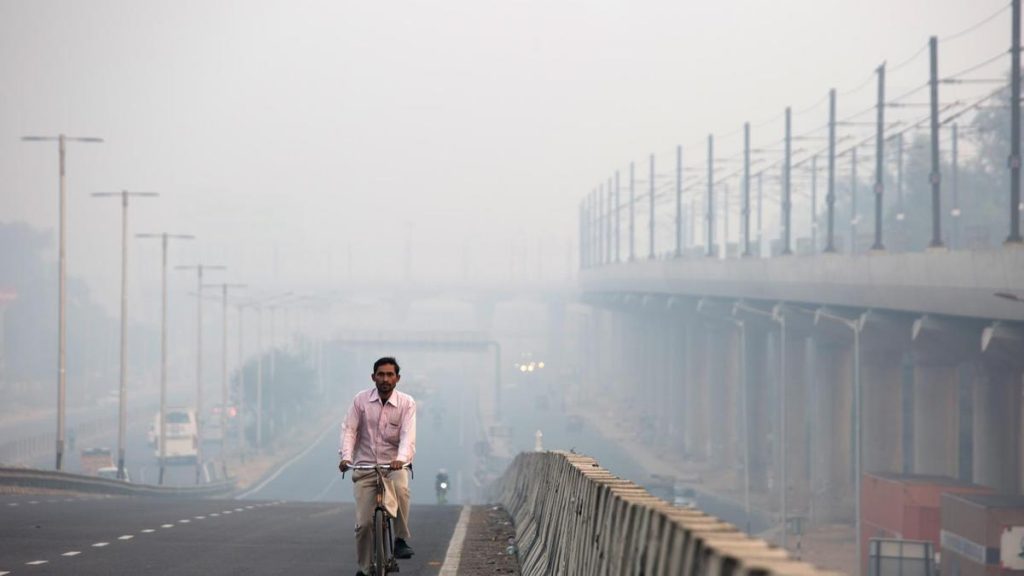It’s not quite Dickens but Delhi now has its own mournful dirge on the city’s dirty air. “No one noticed / When the sparrows left / It was just another / smoggy winter morning,” wrote an unknown poet in the Indian capital. “Delhi bought air purifiers / masks, cough syrup / and tweeted in anger”.
The poem, which has been widely shared among Indians, has struck a chord with the stark way it contrasts middle class consumerism with faux concern for the environment. Air conditioners, gas-guzzling SUVs and firecrackers for the Hindu festival of Diwali, the poem points out, remain on Delhi’s shopping list, even as the city struggles to breathe.
Delhi’s situation is indisputably parlous and seemingly intractable. While it doesn’t boast the dubious distinction of having the dirtiest air in the world, with a population of more than 18 million, Delhi is certainly the largest city with such dangerously polluted air.
It has high levels of particulate matter (PM), tiny particles that can penetrate the lungs and even the bloodstream and are considered one of the most harmful substances for human health. Delhi has a PM of 2.5, meaning its particles are up to 100 times smaller than the width of a human hair.
World Health Organisation guidelines say such particles should not top 25 microgrammes per cubic metre on average. In some areas of Delhi, it often hits 700. By comparison, smoke from the Californian wildfire pushed San Francisco’s PM2.5 concentration up to 221.1 micrograms per cubic metre, the equivalent of smoking about 10 cigarettes per day. On November 8, the day after Diwali, several Air Quality Index monitors maxed out at 999, double the upper limit of what is considered hazardous and equivalent to smoking more than 40 cigarettes a day.
But that reading is not unknown in Delhi. Exactly a year ago, when I was navigating the gray-brown haze that lay thickly over the city, the AQI reading consistently hit 999. Unsurprisingly, this year’s WHO’s ranking of air quality in 4,500 cities listed Delhi as the sixth most polluted.
The consequences are obvious. Not just in the sense of the daily “death of the sun”, as the author Charles Dickens described the smog in Victorian London. Every winter, Delhi residents report burning eyes, persistent coughs, multiple respiratory ailments and a range of other health issues. These are surely the result of breathing toxic air, or the “new tobacco”, as WHO director general Tedros Adhanom Ghebreyesus calls it. And Delhi-dwellers are agonising about the long-term health prospects. Air pollution contributes significantly to non-communicable diseases such as cardiovascular and respiratory conditions and lung cancer, the leading cause of deaths globally.
Those who can afford to try to stop themselves from inhaling too deeply when out in the open and limit their time outdoors. They use masks and respiratory filters when they are on the move and air purifiers at home. Recently, there have been reports of a number of well-heeled citizens — dubbed “pollution refugees” by the Washington Post — fleeing the capital for more salubrious places to live and raise a family. Those who cannot afford to leave stick it out. As one rickshaw-puller recently told the BBC: “I guess hunger is a bigger problem than pollution for us.”
But given the crisis — and it is a crisis — why has it come about and why now? It seems all too easy to blame Diwali firecrackers, car exhausts, construction activity, coal-fired power plants and charcoal braziers. Diwali has long been celebrated, cars have plied Delhi’s roads for at least a century, trucks have long spewed noxious fumes, factories emitted smoke, buildings been developed and roadside chaiwallahs stewed their brews on coal stoves. So why is Delhi choking now?
Obviously, a key reason is the exponential rise in the number of cars and people, and a greater consumption of everything, as well as increased waste disposal. In west Delhi, the burning of plastic and electronic waste is a dirty and frequent business. But according to Siddharth Singh, energy expert and author of the newly published The Great Smog of India, the burning of crop residue from the farming states of Punjab and Haryana, near Delhi is one of the main triggers.
He argues that India’s “green revolution”, starting in the 1960s, unwittingly caused Delhi’s agony. It worked to support food security, crop prices and combine harvesters, which cut and thresh and speed up industrial farming. But the harvesters leave residue that must either be removed by expensive machines — unaffordable to most Indian farmers — or simply be burnt. The farmers do the latter and 23 million tonnes of residue are burned in northern India every winter.
The smoke from the stubble blows into neighbouring Delhi and the air becomes a lethal cocktail of particulate matter, carbon dioxide, nitrogen dioxide and sulphur dioxide.
This is, of course, only an opinion — albeit an informed one — but it might be a good place to start to address the crisis of Delhi’s unbreathable air. Poetry, masks and filters offer only temporary relief.


